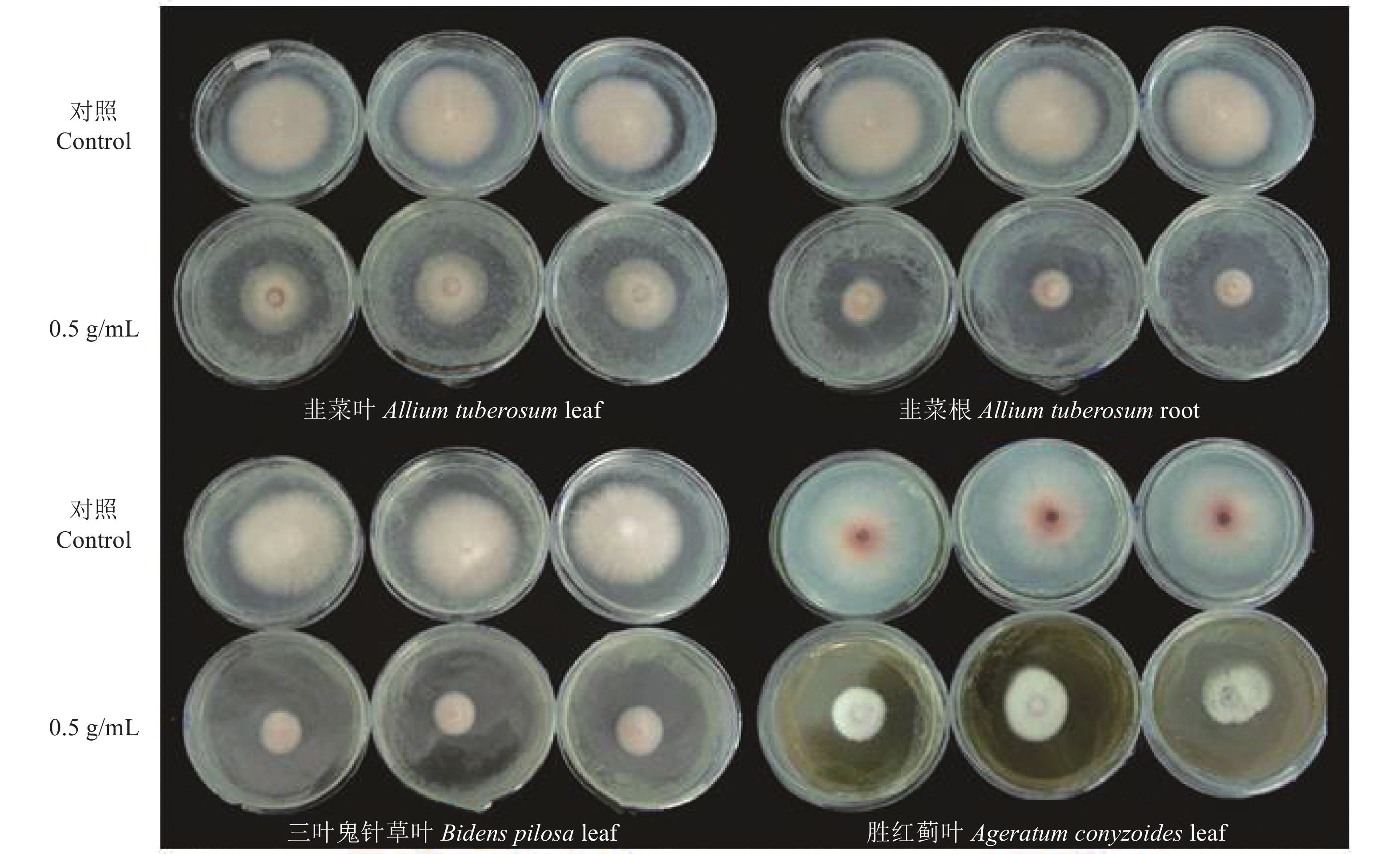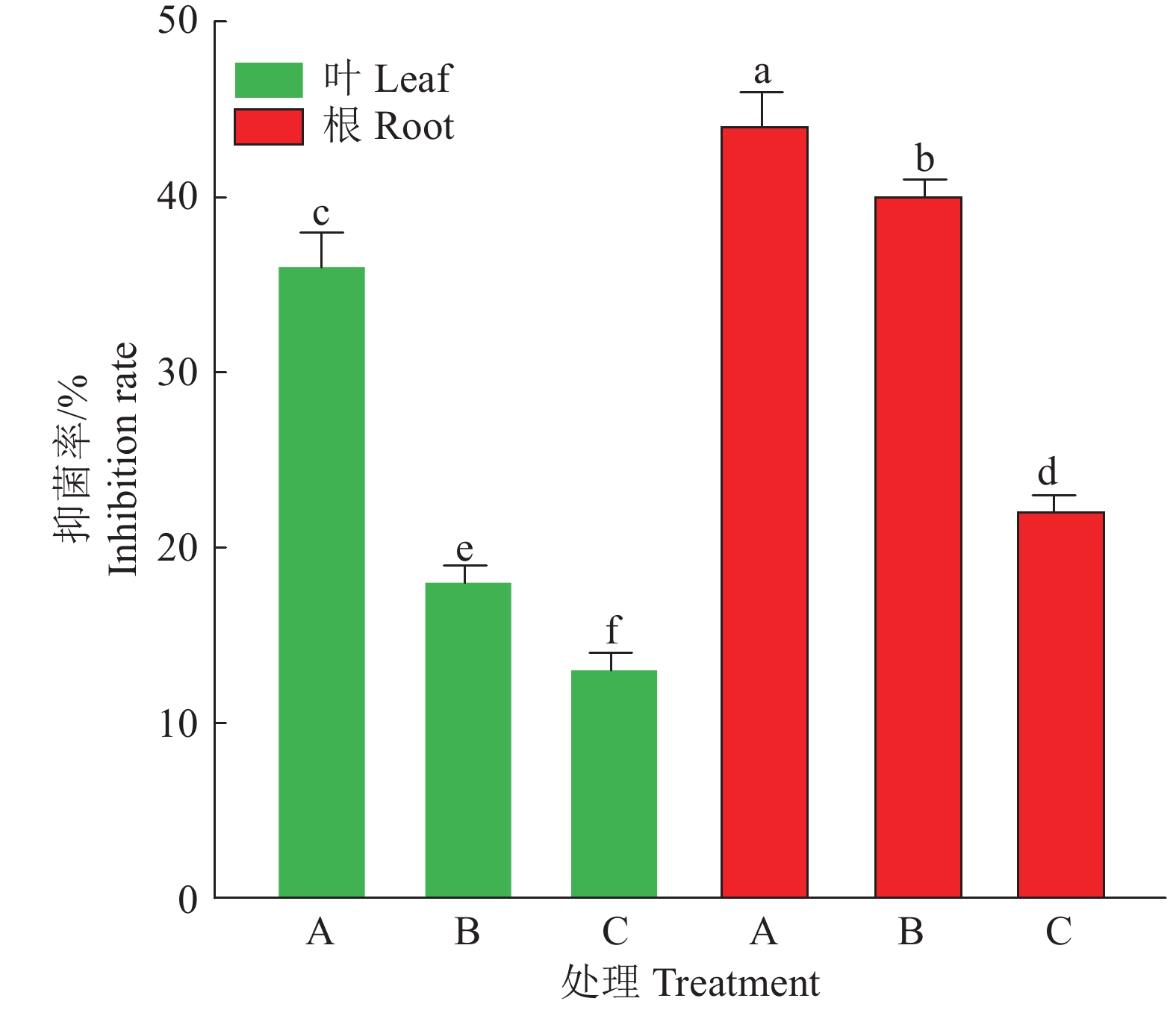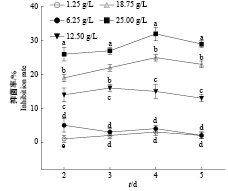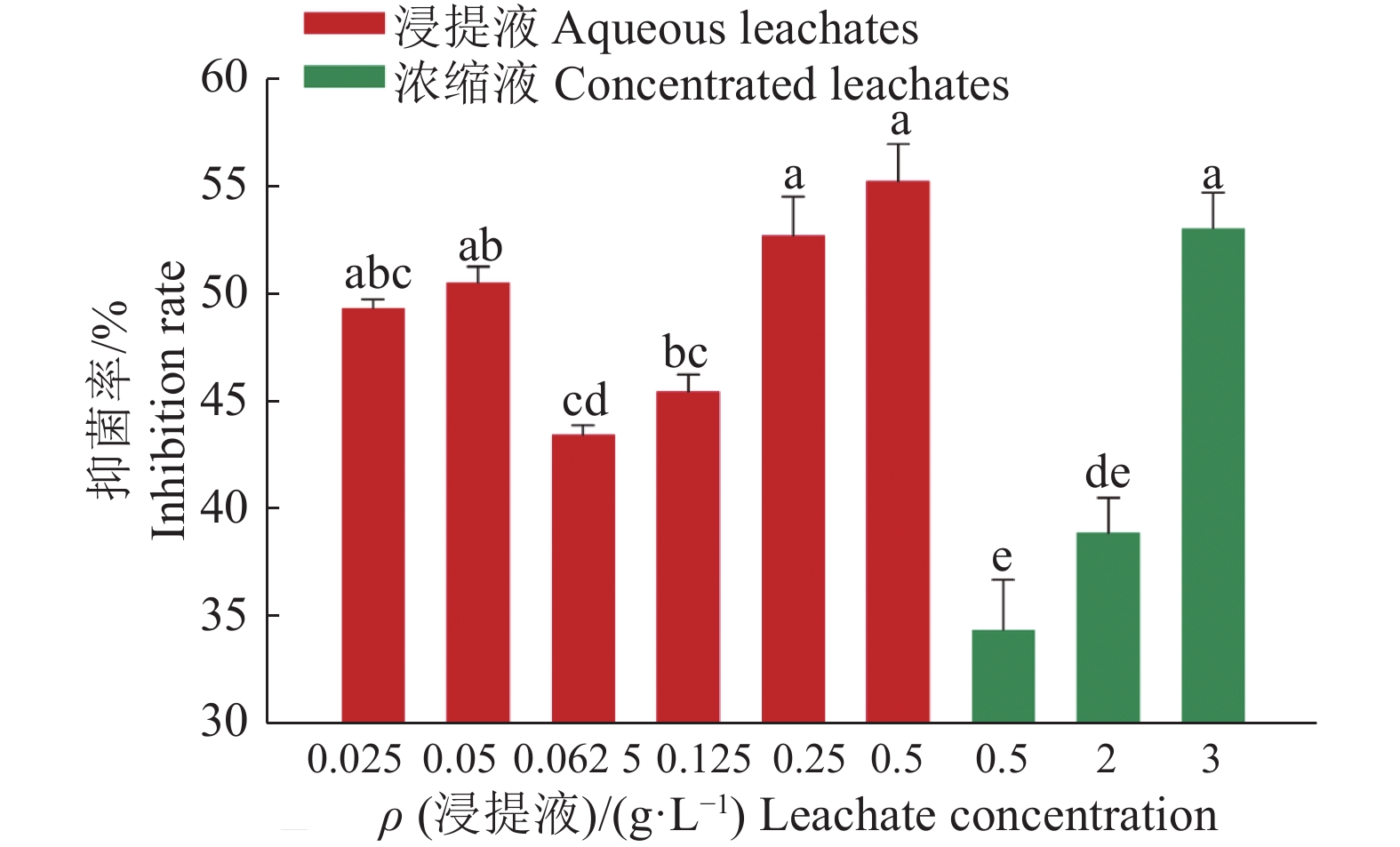Inhibitory effects of aqueous leachates and volatiles from Allium tuberosum and Ageratum conyzoides on Fusarium oxysporum f. sp. cubense
-
摘要:目的
比较不同植物水浸提液对香蕉枯萎病菌4号生理小种(Fusarium oxysporum f. sp. cubense race 4,FOC4)的抑制效果,明确韭菜Allium tuberosum和胜红蓟Ageratum conyzoides抑制FOC4的途径。
方法采用菌丝生长速率法和孢子萌发法,测定了12种植物水浸提液及韭菜和胜红蓟挥发物对FOC4的抑制效果。
结果韭菜根和胜红蓟叶片水浸提液对FOC4具有很好的抑制作用,抑菌率分别达到71%和69%。韭菜叶片和根水浸提液经二氯甲烷萃取,叶片提取液的抑菌率为18.7%,剩余部分的抑菌率为13.0%;根提取液的抑菌率为 39.8%,剩余部分的抑菌率为22.1%;说明水浸提原液中含有的抑菌成分主要为水溶性较低的有机化合物。韭菜叶挥发物对FOC4的抑菌效果比根好,1.25 g/L韭菜鲜叶捣碎后产生的挥发物完全抑制FOC4孢子萌发,1.25 g/L根捣碎后产生的挥发物FOC4孢子萌发数为35个/皿。0.5 g/mL的胜红蓟鲜叶水浸提物对FOC4的抑菌率达到50%以上,抑菌效果明显;胜红蓟挥发物对FOC4的抑制作用不明显,说明胜红蓟的主要抑菌物质并非是挥发物。
结论韭菜的水浸提液和挥发物均可抑制FOC4生长,且挥发物的抑菌效果更好;胜红蓟的水浸提液可抑制FOC4生长,但挥发物的抑制作用不明显。
Abstract:ObjectiveTo compare anti-fungal effects of aqueous extracts of different plants on Fusarium oxysporum f. sp. cubense race4 (FOC4), the causal agent of banana wilt, and further clarify the releasing approaches of anti-fungal compounds from leek (Allium tuberosum Rottler) and Ageratum conyzoides L.
MethodMycelial growth rate method and spore germination method were used to examine the inhibitory effects of aqueous extracts from 12 plant species as well as volatiles from leek and A. conyzoides on mycial growth and spore germination of FOC4.
ResultAqueous extracts of leek and A. conyzoides showed strong inhibitory effects on FOC4 colony growth, the inhibition rates were 71% and 69% respectively. Dichloromethane extracts and residuals of aqueous extracts from leek leaves showed the inhibition rates of 18.7% and 13.0% respectively, and dichloromethane extraction and residuals of aqueous extracts from leek roots showed the inhibition rates of 39.8% and 22.1% respectively, which suggested that the main active ingredients were low water-soluble organic compounds. The antifungal effects of leaf volatiles showed stronger than those of root volatiles for leek. The volatiles from fresh leek leaves mashed in a sealed glass jar completely inhibited FOC4 colony growth at the concentration of 1.25 g/L, and FOC4 spore germination number was 35 per dish after treated with volatiles from leek roots at the same concentration. The inhibitory effects of aqueous extracts of A. conyzoides fresh leaves on FOC4 were obvious, and the inhibition rates were more than 50% at the concentration of 0.5 g/L. The inhibitory effects of A. conyzoides volatiles on FOC4 was not obvious suggesting that the main antifungal compounds of A. conyzoides were not volatiles.
ConclusionAqueous extracts and volatiles from leek have strong inhibitory effects on FOC4, and leek volatiles show higher inhibitory effect. Aqueous extracts of A. conyzoides can inhibit FOC4 growth, but the inhibitory effects of its volatiles were not obvious.
-
Keywords:
- Allium tuberosum /
- Ageratum conyzoides /
- allelopathy /
- volatile /
- aqueous extract /
- banana wilt
-
香蕉Musa nana Lour.是全球贸易量最大的水果之一,世界上有130个国家栽培种植,以中美洲产量最多,其次是亚洲[1]。在中国,香蕉主要分布在广东、广西、福建、台湾、云南和海南,贵州、四川、重庆也有少量栽培。香蕉在种植过程中由于种植模式和浇灌模式等原因,容易受到一些土传病害的感染,其中香蕉枯萎病就是影响最大的一种。香蕉枯萎病又名香蕉巴拿马病、黄叶病,是典型的土传病害,是由尖孢镰刀菌古巴专化型Fusarium oxysporum f. sp. cubense引起的毁灭性真菌病害[2]。该病害的侵染来源主要是带菌的香蕉吸芽、球茎、病株残体和带菌土壤。病原菌从寄主根部伤口侵入寄主,通过寄主维管束向假茎上部及叶部蔓延,堵塞木质部导管,导致植株黄化和枯萎死亡。病原菌腐生能力很强,在土壤中可存活30年以上。感病的香蕉植株一般在6—7月开始发病,8—9月加重,10—11月进入发病高峰阶段。通过带菌的香蕉种苗、土壤和农机具等调运和搬移进行远距离传播,也可通过带菌的水、分生孢子进行近距离扩散。世界上除少数国家外,主要香蕉种植地区均遭受过该病的危害。
当前,香蕉枯萎病的防治包括化学防治、生物防治和选用抗病品种等。在化学防治方面主要使用化学杀菌剂,该防治方法在一定程度上可抑制土壤中的香蕉枯萎病病菌的繁殖,但效果不佳[2],且严重污染土壤环境和破坏水资源,并产生农药残留。生物防治法作为持续防治土传病害的措施,通过引入外来土壤拮抗菌,抑制致病菌的生长。此外,也有一些植物源杀菌剂的研究报道[3-4]。许多植物提取液以及分泌物能有效抑制病原菌,如葱Allium ascalonicum汁液以及葡萄Vitis vinifera叶提取物可抑制黄萎菌 Verticillium dahliae,韭菜Allium tuberosum提取液能高效抑制甘蓝枯萎病菌F. oxysporum f. sp. conglutinans的生长及病害的发生[5-7];胜红蓟Ageratum conyzoides的茎叶挥发物对某些杂草和蔬菜的生长具有抑制作用[8]。对植物源农药解决病原菌抗药性问题的可能性研究也有报道[9-10]。通过培育抗病品种,比如利用芽变选择育种、组培突变体选择育种、杂交育种、基因工程育种等体系和技术来控制香蕉枯萎病也是一条可行和有效的途径。
已有学者研究了韭菜和胜红蓟的抗菌作用[7, 11-12]。对韭菜中抑制香蕉枯萎病菌的有效抑菌成分研究不多,胜红蓟抑制香蕉枯萎病菌的研究也鲜见报道。野外调查发现,在广东省很多地方的香蕉园中自然生长着成片的杂草胜红蓟,这些胜红蓟对防控香蕉枯萎病是否有利?本文预先通过测定多种蔬菜和杂草水浸提液对香蕉枯萎病病原菌的抑菌作用,筛选出抑菌能力较强的韭菜和胜红蓟,然后进一步研究其水浸提液和挥发物对香蕉枯萎病病原菌生长的影响,以期为利用间作韭菜和合理保留果园杂草生态防控香蕉枯萎病菌提供理论依据。
1. 材料与方法
1.1 材料
韭菜Allium tuberosum Rottler、洋葱Allium cepa L.、大蒜Allium sativum L.、芹菜Apium graveolens L.、萝卜Raphanus sativus L.、芋Colocasia esculenta L.、番茄Lycopersicon esculentum Mill.和姜Zingiber officinale Rosc.,种植于广州市华南农业大学校园内农场。胜红蓟Ageratum conyzoides L.、三裂叶蟛蜞菊Wedelia trilobata (L.) Hitchc、龙葵Solanum nigrum L.和三叶鬼针草Bidens pilosa L.采于华南农业大学校园内农场周边草地及广东东莞某香蕉地。
香蕉枯萎病镰刀菌4号生理小种(Fusarium oxysporum f. sp. cubense race 4,FOC4)由华南农业大学农学院植物病理学系姜子德教授提供。
1.2 方法
1.2.1 菌株培养基的配置
马铃薯洗净去皮,称取200 g切成小块,加水煮烂(煮沸20~30 min),用4层纱布过滤,加入葡萄糖20 g,再加琼脂粉15 g,加水至1 000 mL,继续加热搅拌混匀后,121 ℃灭菌20 min左右取出备用。
1.2.2 植物水浸提液的提取
称取新鲜的萝卜茎、洋葱茎、芹菜叶、芋叶、番茄叶、姜茎、蒜叶、蒜茎、韭菜叶、韭菜根、胜红蓟叶、三裂叶蟛蜞菊叶、龙葵叶、三叶鬼针草叶各100 g分别剪成长约2~4 cm,置500 mL三角瓶中,加入蒸馏水200 mL浸没材料,室温静置48 h,过滤上述浸提液得粗提液,质量浓度为0.5 g/mL。将植物粗提液用直径5 cm的0.45 μm微孔滤膜抽滤以除去大部分微生物,再用0.22 μm的微孔滤膜抽滤4次,然后用0.22 μm的注射式过滤器进行3次过滤,最终滤液置于灭过菌的三角瓶里4 ℃存放备用。
1.2.3 植物水浸提液对FOC4菌丝生长的抑制作用
吸取灭菌冷却至60 ℃左右的PDA培养基5 mL置直径9 cm的培养皿中,并迅速加入0.5 g/mL除菌后的植物水浸提液5 mL,快速水平摇匀,待培养基凝固后,在培养皿中间放入直径为0.5 cm的FOC4菌块,第5天测量菌块生长直径。
1.2.4 不同浓度胜红蓟叶水浸提液的配置
将0.5 g/mL的胜红蓟叶粗提液,经过3次0.45 μm微孔滤膜过滤,将其中一部分用旋转蒸发仪(EYELA SB-1100)进行浓缩,使最终质量浓度为3 g/mL,再用0.22 μm的微孔滤膜抽滤除菌,经注射式过滤3次得无菌液。未经浓缩的浸提液滤液经过0.22 μm的微孔滤膜抽滤除菌4次,并经0.22 μm注射式过滤器除菌3次,最后用灭菌水进行稀释,得胜红蓟叶水浸提液质量浓度分别为0.025、0.050、0.062 5、0.125、0.25和0.5 g/mL,胜红蓟叶水浸提液经过浓缩得到质量浓度为0.5、2.0和3.0 g/mL的提取液。
1.2.5 胜红蓟叶挥发物对FOC4的抑菌活性
称取剪碎的长约2 cm胜红蓟叶、根各5、25、50、75 和100 g,分别放入小塑料碗中,对照的塑料碗内不放植物材料,置于高12.5 cm、上底直径22 cm、下底直径 19 cm(容积为4 L)的玻璃缸中,即挥发物质量浓度分别为1.25、6.25、12.50、18.75和25.00 g/L。 将5个PDA培养皿(中央放置直径为0.5 cm的FOC4菌块)分别放入塑料碗周围,然后用3层保鲜膜覆盖玻璃缸,并用橡皮筋箍紧保鲜膜,使植物挥发物尽量保留在玻璃缸里。每天记录菌块生长直径,采用十字交叉法求平均值,得菌块生长直径(cm)。抑菌率(c)计算公式如下:
$$ c = \frac{{\left( {a - 0.5} \right) - \left( {b - 0.5} \right)}}{{\left( {a - 0.5} \right)}} \times 100{\text{%}}\text{,} $$ (1) 式中,a为对照中菌块生长直径,b为处理中菌块生长直径。
1.2.6 韭菜挥发物对FOC4孢子萌发的抑制作用
将韭菜叶、根用粉碎机粉碎后,各称取3、5 g于50 mL烧杯中,放入体积为4 L的玻璃缸中,并把已经准备好的涂有FOC4孢子(103个/mL)的PDA平板分别置于材料旁边,每个玻璃缸放4个平板,再用3层保鲜膜覆盖并用橡皮筋箍紧,使植物挥发物尽量保留在玻璃缸里,挥发物质量浓度相当于0.75和1.25 g/L。每天观察孢子萌发情况,于第3天拍照并计算孢子萌发数量和抑制萌发率(c)。
$$ c = \frac{{a - b}}{a} \times 100{\text{%}}\text{,} $$ (2) 式中,a为对照中香蕉枯萎病镰刀菌孢子萌发数,b为处理中香蕉枯萎病镰刀菌孢子萌发数。
1.2.7 韭菜水浸提液及二氯甲烷萃取液对FOC4菌丝生长的影响
将“1.2.2”中制备的100 mL韭菜叶和根水粗提液倒进500 mL分液漏斗中,加100 mL二氯甲烷进行萃取。然后将萃取液置于50 ℃旋转蒸发仪中除去二氯甲烷,加水定容至100 mL。萃取后的剩液再经过旋转蒸发仪去掉二氯甲烷后,加水溶解、定容至100 mL。将水粗提液、二氯甲烷萃取液和萃取的剩液都通过0.22 μm微孔滤膜除菌。吸取5 mL除菌的粗提液和萃取液于直径为9 cm的培养皿中,对照为蒸馏水,并迅速加入灭过菌且未凝固的PDA培养基(约60 ℃) 5 mL,快速水平摇匀,待培养基凝固后,在培养皿中间放入直径为0.5 cm的FOC4菌块,于第5天测量菌块生长直径,按(1)式计算抑菌率。
1.2.8 数据分析
采用Excel 2013软件分析数据和作图,用SPSS 19 软件对数据进行统计分析(P<0.05)。
2. 结果与分析
2.1 蔬菜与杂草水浸提液对FOC4生长的影响
采用菌丝生长速率法测定了几种常见蔬菜与杂草水浸提液对FOC4菌丝生长的影响结果见图1和图2。抑菌效果较好的有韭菜、三叶鬼针草、三裂叶蟛蜞菊、龙葵、胜红蓟和蒜,对FOC4的抑菌率均在50%以上。其中,韭菜根、三叶鬼针草叶和胜红蓟叶水浸提液抑菌效果最好,抑菌率分别为71%、67%和69%,三者之间差异不显著(图1)。韭菜不同部位的浸提液抑菌效果有明显差异,根浸提液抑菌能力显著高于叶浸提液,为叶浸提液抑菌效果的1.65倍(图1和图2)。
![]() 图 1 几种蔬菜与杂草水浸提液对香蕉枯萎病菌(FOC4)菌丝生长的抑制作用A:韭菜,B:三叶鬼针草,C:芹菜,D:芋,E:番茄,F:三裂叶蟛蜞菊,G:龙葵,H:胜红蓟,I:蒜,J:韭菜,K:蒜,L:萝卜,M:洋葱,N:姜;柱子上方的不同小写字母表示差异显著(P<0.05,Duncan’s法)Figure 1. Inhibitory effects of aqueous extracts of several vegetables and weeds on colony growth of FOC4A:Allium tuberosum,B:Bidens pilosa, C: Apium graveolens,D: Colocasia esculenta,E: Lycopersicon esculentum,F: Wedelia trilobata,G: Solanum nigrum,H: Ageratum conyzoides,I: Allium sativum,J: Allium tuberosum,K: Allium sativum,L: Raphanus sativus,M: Allium cepa,N: Zingiber officinale; Different lowercase letters on the different bars indicated significant difference (P<0.05, Duncan’s method)
图 1 几种蔬菜与杂草水浸提液对香蕉枯萎病菌(FOC4)菌丝生长的抑制作用A:韭菜,B:三叶鬼针草,C:芹菜,D:芋,E:番茄,F:三裂叶蟛蜞菊,G:龙葵,H:胜红蓟,I:蒜,J:韭菜,K:蒜,L:萝卜,M:洋葱,N:姜;柱子上方的不同小写字母表示差异显著(P<0.05,Duncan’s法)Figure 1. Inhibitory effects of aqueous extracts of several vegetables and weeds on colony growth of FOC4A:Allium tuberosum,B:Bidens pilosa, C: Apium graveolens,D: Colocasia esculenta,E: Lycopersicon esculentum,F: Wedelia trilobata,G: Solanum nigrum,H: Ageratum conyzoides,I: Allium sativum,J: Allium tuberosum,K: Allium sativum,L: Raphanus sativus,M: Allium cepa,N: Zingiber officinale; Different lowercase letters on the different bars indicated significant difference (P<0.05, Duncan’s method)2.2 韭菜挥发物对FOC4孢子萌发的影响
韭菜叶和根捣碎后产生的挥发物对FOC4孢子萌发有显著抑制作用(图3和图4)。1.25 g/L韭菜叶产生的挥发物完全抑制孢子萌发,1.25 g/L根挥发物的孢子萌发数为35个/皿,抑制率为43%,均与对照差异极显著;0.75 g/L叶挥发物处理的孢子萌发数为22个/皿,0.75 g/L根挥发物的孢子萌发数为41个/皿,均与对照差异显著;相同浓度叶挥发物处理的FOC4孢子萌发数始终低于根挥发物(图3)。
2.3 韭菜水浸提液及二氯甲烷萃取后对FOC4活性的影响
韭菜叶与根的水浸提液对FOC4抑制效果差异显著(图5),叶水浸提液的抑菌率为35.9%,根水浸提液的抑菌率为42.3%。水浸提液用二氯甲烷萃取后,叶萃取液的抑菌率为18.7%,剩余部分的抑菌率为13.0%,抑菌率分别为叶水浸提液的52%和36%;根萃取液的抑菌率为39.8%,剩余部分的抑菌率为22.1%,抑菌率分别为根水浸提液的94%和52%。
![]() 图 5 韭菜叶和根水浸提液及二氯甲烷萃取液对香蕉枯萎病病菌(FOC4)的抑菌活性A:水浸提原液,B:二氯甲烷萃取液,C:二氯甲烷萃取剩余部分;柱子上方的不同小写字母表示差异显著(P<0.05,Duncan’s法)Figure 5. Inhibitory effects of aqueous leachates of Allium tuberosum leaves and roots and their dichloromethane extracts on colony growth of FOC4A: Aqueous leachate,B: CH2Cl2 extract, C: Residual fraction of CH2Cl2 extraction; Different lowercase letters on the bar indicated significant difference (P<0.05, Duncan’s method)
图 5 韭菜叶和根水浸提液及二氯甲烷萃取液对香蕉枯萎病病菌(FOC4)的抑菌活性A:水浸提原液,B:二氯甲烷萃取液,C:二氯甲烷萃取剩余部分;柱子上方的不同小写字母表示差异显著(P<0.05,Duncan’s法)Figure 5. Inhibitory effects of aqueous leachates of Allium tuberosum leaves and roots and their dichloromethane extracts on colony growth of FOC4A: Aqueous leachate,B: CH2Cl2 extract, C: Residual fraction of CH2Cl2 extraction; Different lowercase letters on the bar indicated significant difference (P<0.05, Duncan’s method)2.4 胜红蓟叶挥发物对FOC4活性的影响
从图6 可见,胜红蓟叶捣碎后挥发物对FOC4抑菌作用没有水浸提液强(图1)。25.00 g/L挥发物在第2天时抑菌率只有25.0%,第4天达到最高为32.0%,第5天回落到29.0%;18.75、12.50、6.25和1.25 g/L挥发物的抑菌率第2天分别为19.6%、14.4%、4.6%和0.8%,第5天分别为23.3%、13.2%、2.7%和2.6%,抑菌率并没有太大的变化,对FOC4活性抑制处于一个相对平缓的水平。
![]() 图 6 胜红蓟叶挥发物对香蕉枯萎病菌(FOC4)菌丝生长的抑制作用相同时间不同小写字母表示不同浓度间的差异显著(P<0.05,Duncan’s法)Figure 6. Inhibitory effects of volatiles from Ageratum conyzoides leaves on colony growth of FOC4Different lowercase letters at the same time indicated significant difference among different concentrations (P<0.05, Duncan’s method)
图 6 胜红蓟叶挥发物对香蕉枯萎病菌(FOC4)菌丝生长的抑制作用相同时间不同小写字母表示不同浓度间的差异显著(P<0.05,Duncan’s法)Figure 6. Inhibitory effects of volatiles from Ageratum conyzoides leaves on colony growth of FOC4Different lowercase letters at the same time indicated significant difference among different concentrations (P<0.05, Duncan’s method)2.5 胜红蓟叶水浸提液对FOC4活性的影响
胜红蓟叶水浸提液对FOC4的抑制效果见图7和图8。在0.5 g/mL质量浓度下抑菌率达到55%,随着浓度的稀释,当质量浓度为0.025 g/mL时,抑菌率为49%,与0.5 g/mL时差异不显著。质量浓度为0.125和0.062 5 g/mL的抑菌率低于0.05和0.025 g/mL的抑菌率(图7)。浸提液浓缩后,高质量浓度(3 g/mL)的抑菌率反而比0.5 g/mL浸提液的低,但两者差异不显著。当浓缩液稀释到2和0.5 g/mL时,其抑菌率明显降低,分别为38%和34%,均显著低于本试验其他浓度下的抑菌率(图8)。这表明,在水浸提物浓缩时部分挥发性的抑菌物质已经蒸发,导致抑菌作用比浓缩前的原水浸提液还弱。
![]() 图 7 胜红蓟叶水浸提液对香蕉枯萎病菌(FOC4)的抑制效果前面3个质量浓度(3.0,2.0,0.5)代表叶水浸液经过浓缩后稀释获得的浸提液,后面6个浓度代表叶水浸提获得的浸提液Figure 7. Inhibitory effects of different concentrations of aqueous leachates of Ageratum conyzoides leaves on FOC4 colony growthThe first three concentrations (3.0, 2.0, 0.5) represented the extracts obtained by diluting the concentrated leaf aqueous leachates, and the latter six concentrations represented water leachates of leaves
图 7 胜红蓟叶水浸提液对香蕉枯萎病菌(FOC4)的抑制效果前面3个质量浓度(3.0,2.0,0.5)代表叶水浸液经过浓缩后稀释获得的浸提液,后面6个浓度代表叶水浸提获得的浸提液Figure 7. Inhibitory effects of different concentrations of aqueous leachates of Ageratum conyzoides leaves on FOC4 colony growthThe first three concentrations (3.0, 2.0, 0.5) represented the extracts obtained by diluting the concentrated leaf aqueous leachates, and the latter six concentrations represented water leachates of leaves![]() 图 8 不同浓度胜红蓟叶浸提液和浓缩液对香蕉枯萎病菌(FOC4)的抑菌率柱子上方的不同小写字母表示差异显著(P<0.05,Duncan’s法)Figure 8. Inhibition rate of FOC4 colony cultured in aqueous leachates and concentrated leachates of Ageratum conyzoides leaves at different concentrationsDifferent lowercase letters on the bar indicated significant difference (P<0.05, Duncan’s method)
图 8 不同浓度胜红蓟叶浸提液和浓缩液对香蕉枯萎病菌(FOC4)的抑菌率柱子上方的不同小写字母表示差异显著(P<0.05,Duncan’s法)Figure 8. Inhibition rate of FOC4 colony cultured in aqueous leachates and concentrated leachates of Ageratum conyzoides leaves at different concentrationsDifferent lowercase letters on the bar indicated significant difference (P<0.05, Duncan’s method)3. 讨论与结论
植物化感物质主要是植物次生代谢产物[13-14],其中,酚类和萜类化合物较为常见。前人利用葱属植物与花卉间作模式预防花卉地下病虫害,这可能是由于葱属植物根系分泌出来的挥发物起了关键的作用[15-17]。一般来说,植物根系分泌物浓度比较低,也有很多人质疑这么低的浓度在土壤中究竟能起到多大的作用[18]。本文通过水浸提的方法筛选出对FOC4菌落生长抑制作用较好的几种植物,它们分别是韭菜、胜红蓟和三叶鬼针草。胜红蓟和三叶鬼针草作为入侵植物,其浸提液对FOC4具有强烈的抑制作用。香蕉地往往都是单一种植,在缺少其他地被植物时更容易受到土传病害病原菌如FOC4的感染。本文选取韭菜作为试验材料一方面是因为其对FOC4有较强的抑制作用;另一方面韭菜作为经济作物在香蕉间种中预防香蕉枯萎病的同时可以为农户带来一定的经济收入。由于香蕉地经常出现的胜红蓟和三叶鬼针草对香蕉枯萎病病原菌也具有强烈的抑制作用,本文提出了在香蕉地中应该保留这些入侵植物,而不是完全变为裸地。这些杂草还可以起到减少水土流失的作用。
香蕉枯萎病菌的危害受到国内外的高度关注,已经成为香蕉产业发展的制约因素,但目前对该病的防治仍缺乏有效的方法。本研究先利用选取的12种蔬菜和杂草的水浸提液来研究其对FOC4生长的影响,发现蔬菜类的韭菜和作为入侵植物的胜红蓟和三叶鬼针草水浸提液的抑菌效果较好,韭菜作为常见的蔬菜,与香蕉间作便于收割。0.5 g/mL韭菜水浸提液对FOC4的抑菌作用最强,且韭菜根部浸提液的抑制作用明显高于叶部,蒜的效果次之。杂草中三叶鬼针草和胜红蓟的浸提液抑制FOC4菌落生长的能力也很高。Zhang等[19]曾模拟韭菜根部在自然状态无损伤情况下释放的挥发性物质对FOC4孢子萌发有较好的抑制效果。 韭菜对多种植物病虫害和病源有显著的抑制效果[20-22]。本研究发现韭菜叶捣碎后挥发物在质量浓度为1.25 g/L时可以完全抑制孢子萌发,且叶挥发物的抑菌效果高于根挥发物,这说明在剪碎的情况下叶片比根释放出更多的挥发性抑菌物质。韭菜根水浸提液的抑菌作用要比叶水浸提液的抑菌作用强;韭菜根水浸提液经二氯甲烷提取后也可抑制FOC4的生长,但抑菌效果略低于韭菜根浸提原液。原因可能是有些抑菌物质是水溶性的没有提取出来,也可能是浸提液二氯甲烷萃取过程中经过旋转蒸发仪的浓缩蒸发,某些易挥发性抑菌物质在浓缩过程中损失,故抑菌活性降低。此外,韭菜浸提原液抑菌效果与韭菜捣碎后的挥发物抑菌效果呈相反结果,即韭菜根浸提原液的抑菌效果高于韭菜叶浸提原液的抑菌效果,而韭菜叶捣碎后挥发物的抑菌效果高于韭菜根捣碎后的挥发物。表明根中抑菌物质一部分是水溶性的,挥发性抑菌物质在叶片中含量比较高。
本试验表明胜红蓟叶挥发物和水浸提液对FOC4有明显的抑制作用,叶挥发物的抑菌效果明显低于叶水浸提液,说明胜红蓟的抑菌物质主要是水溶性物质。胜红蓟叶浸提液在经过旋转蒸发仪浓缩后抑菌能力显著下降,说明叶浸提液中含有一定的挥发性抑菌物质。胜红蓟产生和释放的次生物质对许多害虫、病原菌和杂草都有显著的抑制作用[23-24],在引种胜红蓟的柑橘园中病原真菌能得到有效的控制[25]。本研究发现胜红蓟水浸提液对香蕉枯萎病菌有很好的抑菌作用。南方很多果园中均有大量胜红蓟生长,这些野生的杂草可能对防治香蕉枯萎病等土传病害有重要作用。研究结果为农业病虫害的生态防控提供了新的研究思路及潜在的防控措施,并对研制新型的植物源生物农药以及控制农林有害生物具有指导意义。
-
图 1 几种蔬菜与杂草水浸提液对香蕉枯萎病菌(FOC4)菌丝生长的抑制作用
A:韭菜,B:三叶鬼针草,C:芹菜,D:芋,E:番茄,F:三裂叶蟛蜞菊,G:龙葵,H:胜红蓟,I:蒜,J:韭菜,K:蒜,L:萝卜,M:洋葱,N:姜;柱子上方的不同小写字母表示差异显著(P<0.05,Duncan’s法)
Figure 1. Inhibitory effects of aqueous extracts of several vegetables and weeds on colony growth of FOC4
A:Allium tuberosum,B:Bidens pilosa, C: Apium graveolens,D: Colocasia esculenta,E: Lycopersicon esculentum,F: Wedelia trilobata,G: Solanum nigrum,H: Ageratum conyzoides,I: Allium sativum,J: Allium tuberosum,K: Allium sativum,L: Raphanus sativus,M: Allium cepa,N: Zingiber officinale; Different lowercase letters on the different bars indicated significant difference (P<0.05, Duncan’s method)
图 5 韭菜叶和根水浸提液及二氯甲烷萃取液对香蕉枯萎病病菌(FOC4)的抑菌活性
A:水浸提原液,B:二氯甲烷萃取液,C:二氯甲烷萃取剩余部分;柱子上方的不同小写字母表示差异显著(P<0.05,Duncan’s法)
Figure 5. Inhibitory effects of aqueous leachates of Allium tuberosum leaves and roots and their dichloromethane extracts on colony growth of FOC4
A: Aqueous leachate,B: CH2Cl2 extract, C: Residual fraction of CH2Cl2 extraction; Different lowercase letters on the bar indicated significant difference (P<0.05, Duncan’s method)
图 6 胜红蓟叶挥发物对香蕉枯萎病菌(FOC4)菌丝生长的抑制作用
相同时间不同小写字母表示不同浓度间的差异显著(P<0.05,Duncan’s法)
Figure 6. Inhibitory effects of volatiles from Ageratum conyzoides leaves on colony growth of FOC4
Different lowercase letters at the same time indicated significant difference among different concentrations (P<0.05, Duncan’s method)
图 7 胜红蓟叶水浸提液对香蕉枯萎病菌(FOC4)的抑制效果
前面3个质量浓度(3.0,2.0,0.5)代表叶水浸液经过浓缩后稀释获得的浸提液,后面6个浓度代表叶水浸提获得的浸提液
Figure 7. Inhibitory effects of different concentrations of aqueous leachates of Ageratum conyzoides leaves on FOC4 colony growth
The first three concentrations (3.0, 2.0, 0.5) represented the extracts obtained by diluting the concentrated leaf aqueous leachates, and the latter six concentrations represented water leachates of leaves
图 8 不同浓度胜红蓟叶浸提液和浓缩液对香蕉枯萎病菌(FOC4)的抑菌率
柱子上方的不同小写字母表示差异显著(P<0.05,Duncan’s法)
Figure 8. Inhibition rate of FOC4 colony cultured in aqueous leachates and concentrated leachates of Ageratum conyzoides leaves at different concentrations
Different lowercase letters on the bar indicated significant difference (P<0.05, Duncan’s method)
-
[1] 邵瑞清. 中国香蕉贸易发展研究[D]. 海口: 海南大学, 2011. [2] 钟群有, 郑卓辉, 彭增明, 等. 香蕉枯萎病生物防治研究概述[J]. 广东农业科学, 2007, 7(3): 64-65. [3] 李晓菲, 徐政. 植物源杀菌剂研究进展[J]. 南方农业, 2018, 12(13): 40-42. [4] RISTIĆ M, SOKOVIĆ M, GRUBIŠIĆ D, et al. Chemical analysis and antifungal activity of the essential oil of Achillea atrata L[J]. J Essent Oil Res, 2004, 16(1): 75-78. doi: 10.1080/10412905.2004.9698654
[5] 曾凤, 黄永红, 凌键, 等. 韭菜水提液对甘蓝枯萎病菌抑制作用初探[J]. 中国蔬菜, 2016(1): 60-63. doi: 10.3969/j.issn.1000-6346.2016.01.011 [6] LI E, WANG G, YANG Y, et al. Microscopic analysis of the compatible and incompatible interactions between Fusarium oxysporum f. sp. conglutinans and cabbage[J]. Eur J Plant Pathol, 2015, 141(3): 597-609. doi: 10.1007/s10658-014-0567-6
[7] 赵刚, 张卫娜, 左存武, 等. 韭菜提取物及其主要活性物质防控苹果轮纹病发生的研究[J]. 中国生物防治学报, 2017, 33(2): 273-280. [8] 江贵波, 高伟佳, 陆梓华. 胜红蓟挥发物对杂草和蔬菜的化感作用[J]. 河南农业科学, 2014, 43(2): 92-95. doi: 10.3969/j.issn.1004-3268.2014.02.021 [9] 叶倩, 左浩江, 廖虹瑜, 等. 粗壮女贞提取物的体外抑菌作用研究[J]. 现代预防医学, 2013, 40(7): 1320-1322. [10] WHYTE L, HUANG Y Y, TORRES K, et al. Molecular mechanisms of resveratrol action in lung cancer cells using dual protein and microarray analyses[J]. Cancer Res, 2007, 67(24): 12007-12017. doi: 10.1158/0008-5472.CAN-07-2464
[11] 杨静美, 黄建川, 王闯, 等. 韭菜对香蕉枯萎病菌两种细胞壁降解酶活性的影响[J]. 仲恺农业工程学院学报, 2015, 28(1): 64-66. doi: 10.3969/j.issn.1674-5663.2015.01.013 [12] 刘彦, 张冬莲, 吕金丽, 等. 不同条件下韭菜汁对茶树轮斑病孢子萌发的抑制活性研究[J]. 农家科技(下旬刊), 2017(8): 270-271. [13] RICE E L. Allelopathy [M]. 2ed. Floradia: Academic Press Inc., 1984: 119.
[14] ZENG R S. Allelopathy in Chinese ancient and modern agriculture[M]// ZENG R S, MALLIK A, LUO S M. Allelopathy in sustainable agriculture and forestry. New York: Springer, 2008: 39-59.
[15] 卫煜英, 万仁忠. 韭菜挥发油主要成份的气相色谱/质谱分析[J]. 分析化学, 1996, 24(2): 192-194. [16] 姚安庆. 洋葱、大蒜、韭菜抗菌作用的比较[J]. 贵州农业科学, 2004, 32(3): 56-57. doi: 10.3969/j.issn.1001-3601.2004.03.020 [17] 周国顺, 甘贤友, 孙俊良, 等. 番菇韭菜间作防治番茄病毒病研究简报[J]. 河南职技师院学报, 1992, 20(3): 52-53. [18] POLLOCK J L, CALLAWAY R M, THELEN G C, et al. Catechin–metal interactions as a mechanism for conditional allelopathy by the invasive plant Centaurea maculosa[J]. J Ecol, 2009, 97(6): 1234-1242. doi: 10.1111/jec.2009.97.issue-6
[19] ZHANG H, MALLIK A, ZENG R S. Control of Panama disease of banana by rotating and intercropping with Chinese chive (Allium tuberosum Rottler): Role of plant volatiles[J]. J Chem Ecol, 2013, 39(2S1): 243-252. doi: 10.1007/s10886-013-0243-x
[20] HUANG Y H, WANG R C, LI C H, et al. Control of Fusarium wilt in banana with Chinese leek[J]. Eur J Plant Pathol, 2012, 134(1): 87-95. doi: 10.1007/s10658-012-0024-3
[21] AUGER J. Insecticidal and fungicidal potential of Allium substances as biofumigants[J]. Agondustria, 2004, 3(3): 5-8.
[22] 黄永红, 李春雨, 左存武, 等. 韭菜对巴西香蕉枯萎病发生的抑制作用[J]. 中国生物防治学报, 2011, 27(3): 344-348. [23] 孔垂华, 黄寿山, 胡飞. 胜红蓟化感作用研究: V: 挥发油对真菌、昆虫和植物的生物活性及其化学成分[J]. 生态学报, 2001, 21(4): 584-587. [24] KONG C, HU F, XU X. Allelopathic potential and chemical constituents of volatiles from Ageratum conyzoides under stress[J]. J Chem Ecol, 2002, 28(6): 1173-1182. doi: 10.1023/A:1016229616845
[25] 胡飞, 孔垂华, 徐效华, 等. 胜红蓟黄酮类物质对柑桔园主要病原菌的抑制作用[J]. 应用生态学报, 2002, 13(9): 1166-1168. doi: 10.3321/j.issn:1001-9332.2002.09.026 -
期刊类型引用(7)
1. 李霜霜,黄益强,钟春燕. 我国香蕉枯萎病防控研究进展. 安徽农业科学. 2025(06): 11-16 .  百度学术
百度学术
2. 谢一琪,牛玉,刘子记,于仁波,韩旭. 韭菜根系分泌物对苦瓜枯萎病菌的化感作用. 热带作物学报. 2022(01): 173-184 .  百度学术
百度学术
3. 骆世明. 生态农业发展的回顾与展望. 华南农业大学学报. 2022(04): 1-9 .  本站查看
本站查看
4. 钟飞腾,王诗霖,卢诗丽,袁梅婷,刘月廉. 碱性硅肥对香蕉枯萎病的影响. 中国南方果树. 2022(05): 79-82 .  百度学术
百度学术
5. 刘嘉方,李蕾,云兴福. 烟草浸提液对番茄晚疫病菌的化感抑制效应机理研究. 中国生物防治学报. 2022(05): 1231-1241 .  百度学术
百度学术
6. 杜浩,朱文,赵丽娟,只佳增,刘学敏. 藿香蓟在农业中的利用及其潜在风险研究进展. 亚热带农业研究. 2022(03): 211-216 .  百度学术
百度学术
7. 滕秋梅,杨晓东,何成新,徐广平,黄玉清,张德楠,孙英杰,牟海飞,韦绍龙,周龙武. 韭菜化感物质草莓酸对香蕉枯萎病菌的影响. 广西植物. 2022(11): 1901-1912 .  百度学术
百度学术
其他类型引用(6)





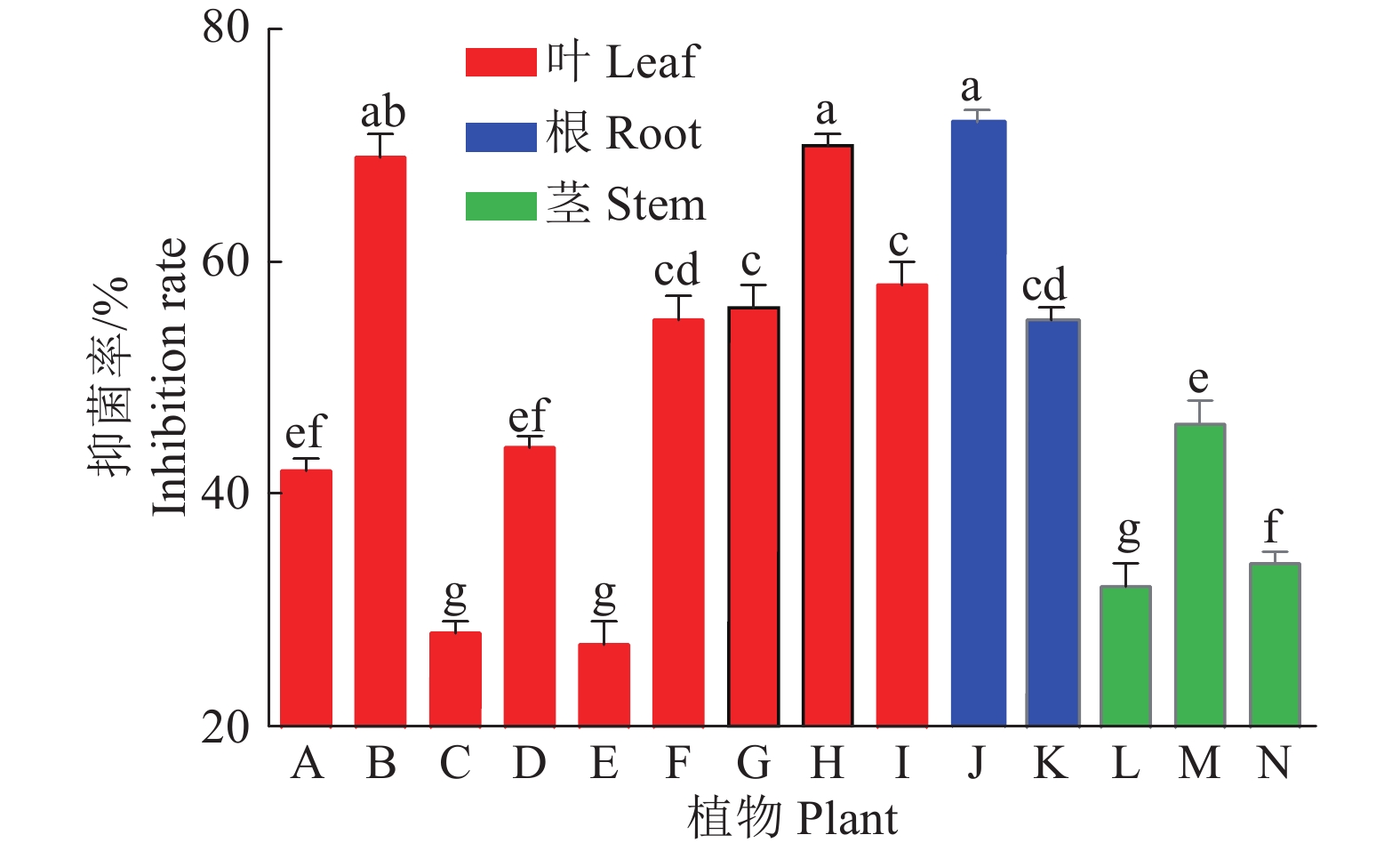
 下载:
下载:
